A Comprehensive State-of-the-Art Review on the Recent Developments in Greenhouse Drying
Abstract
1. Introduction
1.1. Solar Drying
1.1.1. Open Sun Drying
1.1.2. Direct Solar Drying
1.1.3. Indirect Solar Drying
2. Greenhouse Dryer for Different Products
2.1. Importance of Greenhouse Drying
- (i)
- The fabrication cost is low.
- (ii)
- The structure of a GHD can be used throughout the year, which helps to increase the production of a dried crop.
- (iii)
- Using a GHD improves the use of solar energy in terms of efficiency.
2.2. Greenhouse Dryersfor Different Products
2.2.1. Red Chili
2.2.2. Turmeric
2.2.3. Copra
2.2.4. Grapes
2.2.5. Peanuts
2.2.6. Fish
3. Classification of the Greenhouse Drying System
3.1. Natural Convection Solar Greenhouse Dryer
3.2. Forced Convection Greenhouse Dryer
3.3. Solar Hybrid Greenhouse Dryer
4. Performance of Greenhouse Dryer in No Load Condition
4.1. Overall Heat Transfer Coefficient
4.2. Dimensionless Number of the Experiments
4.3. Coefficient of Diffusivity
4.4. Heat Loss Factor
4.5. Heat Utilization Factor
4.6. Air Exchange per Hour
4.7. Electrical Efficiency and Solar Photovoltaic System (SPV) Efficiency
5. Performance of the Greenhouse Dryer under Load Conditions
5.1. Ratio of Moisture ()
5.2. Drying System Efficiency ()
6. Thermal Modelling of Greenhouse Dryers
6.1. Necessity of Thermal Models
6.2. Thermal Modelling of Solar Greenhouse Drying Systems
6.2.1. Thermal Modelling of Natural Convection Solar Greenhouse Dryer
6.2.2. Thermal Modeling of a Forced Convection Solar Greenhouse Dryer
7. Environomical Analyses of Greenhouse Dryer
7.1. Embodied Energy
7.2. Energy Payback Time (EPBT)
7.3. CO2 Emission
7.4. Cost Analysis
7.5. Carbon Mitigation and Earned Carbon Credit
8. Analysis on the Recent Trends of Greenhouse Dryers
8.1. Studies Conducted on Natural Convection Greenhouse Dryers
8.2. Studies Conducted on Forced Convection Greenhouse Dryers
8.3. Studies Conducted on Hybrid Greenhouse Dryers
8.4. Studies Conducted on Environomical Aspects of Greenhouse Dryers
9. Challenges and Opportunities
- The maximum acceptable temperature needs to be determined without compromising the quality of the dried crop. Hence analyzing the optimum drying air temperature is needed when drying crops.
- The proper utilization of moist air needs to occur in order to decrease the relative humidity and increase the drying rate.
- The energy and exergy efficiencies should be analyzed properly as the present research is limited with regard to greenhouse dryers.
- The comprehensive numerical models for the greenhouse drying of crops are needed to be developed as they include changes to the moisture on the surface.
10. Final Remarks and Conclusions
- The choice of solar greenhouse dryer varies according to region, and generalizing it to a specific orientation and shape is not possible. Among the numerous shapes explored in greenhouse dryer design, Quonset and even span types are commonly utilized globally, with the even span being favored since it receives more solar radiation in all seasons. When compared with other orientations, the east–west direction is chosen because of its lower energy requirements for heating and cooling as well as its capacity to absorb more solar radiation into the dryer. Commonly utilised as cladding materials are low-density polyethylene films that are stabilized with ultraviolet, infrared, and anti-drop technology.
- A combination of latent heat storage and sensible heat storage units in the greenhouse dryer can be employed to attain the constant drying of products in all seasons. In this situation, the greenhouse dryer can be equipped with a black-painted gravel bed and a PCM (paraffin wax). Use of a heat exchanger and heat pump can be used for providing additional heat to the greenhouse at lower ambient temperatures.
- On the basis of different statistical parameters (reduced chi-square, root mean square error, and mean absolute error) the different drying models (thin layer) that are available in the literature are compared and confirmed with the data of experimental drying curves. The study provides a thorough investigation of the several thin layer models that are available, and the best-fitting models are listed, based on the type of dryer, how it operates, and the goods (fruits, vegetables, and spices). It is also based on the mode of operation, product, location, and kind of greenhouse dryer. This description can be used as a reference tool for choosing an appropriate thin layer model. As a result, it is challenging to characterize the drying behavior using a single thin layer model of a product, and it is almost impossible to construct a generic thin layer model.
11. Recommendations and Future Scope of Research
- (a)
- A thorough experimental investigation is required to investigate the feasibility of building a combined thermal storage unit (latent heat and sensible) used in the greenhouse dryer in order to capitalize on a higher specific heat capacity and cost effectiveness. To avoid overuse of thermal storage elements, the ideal thickness of the latent heat storage and sensible heat storage system must be estimated in advance.
- (b)
- The thermal performance of the hybrid greenhouse dryer can be investigated at different mass flow rates and porosity values.
- (c)
- The thermal performance of the proposed system can be investigated by recirculation of exhaust air inside the drying chamber.
- (d)
- The solar air heater can be modified with heat storage-based material such as PCM and performance analysis can be done.
- (e)
- The CFD analysis of the proposed system can be conducted and compared with other investigators.
- (f)
- The thermal performance of the proposed hybrid greenhouse dryer can be further investigated by varying the packed bed materials and porosity values.
- (g)
- A complete experimental and simulation analysis on the thin-layer model must be performed, taking into account characteristics such as the dryer’s boundary conditions, the product’s shrinkage behaviour, the equilibrium moisture content, time-varying and diffusivity parameters such as the uncertainty values, and temperature; these have an impact during the drying rate measurements. These assumptions need to be taken into account when creating of future thin-layer models. This will contribute to improving the predictability of product drying behavior.
Author Contributions
Funding
Institutional Review Board Statement
Informed Consent Statement
Data Availability Statement
Conflicts of Interest
References
- Sharma, N.; Garcha, S.; Singh, S. Potential of Lactococcus lactis subsp. lactis MTCC 3041 as a biopreservative. J. Microbiol. Biotechnol. Food Sci. 2019, 2019, 168–171. [Google Scholar]
- Singh, S.; Kumar, S. Testing method for thermal performance-based rating of various solar dryer designs. Sol. Energy 2012, 86, 87–98. [Google Scholar] [CrossRef]
- Ayres, R.U.; Walter, J. The greenhouse effect: Damages, costs and abatement. Environ. Resour. Econ. 1991, 1, 237–270. [Google Scholar] [CrossRef]
- Kumar, M.; Kumar, A. Performance assessment and degradation analysis of solar photovoltaic technologies: A review. Renew. Sustain. Energy Rev. 2017, 78, 554–587. [Google Scholar] [CrossRef]
- Supranto Sopian, K.; Daud, W.; Othman, M.; Yatim, B. Design of an experimental solar assisted dryer for palm oil fronds. Renew. Energy 1999, 16, 643–646. [Google Scholar] [CrossRef]
- Belessiotis, V.; Delyannis, E. Solar drying. Sol. Energy 2011, 85, 1665–1691. [Google Scholar] [CrossRef]
- Bahammou, Y.; Tagnamas, Z.; Lamharrar, A.; Idlimam, A. Thin-layer solar drying characteristics of Moroccan horehound leaves (Marrubium vulgare L.) under natural and forced convection solar drying. Sol. Energy 2019, 188, 958–969. [Google Scholar] [CrossRef]
- Essalhi, H.; Benchrifa, M.; Tadili, R.; Bargach, M.N. Experimental and theoretical analysis of drying grapes under an indirect solar dryer and in open sun. Innov. Food Sci. Emerg. Technol. 2018, 49, 58–64. [Google Scholar] [CrossRef]
- Sharma, A.; Chen, C.R.; Lan, N.V. Solar-energy drying systems: A review. Renew. Sustain. Energy Rev. 2009, 13, 1185–1210. [Google Scholar] [CrossRef]
- Kumar, A.; Rai, A.K. Comparative Study of Open Sun Drying & Solar Cabinet Drying Techniques for Drying of Green Chilies. Int. J. Prod. Technol. Manag. 2016, 7, 18–26. [Google Scholar]
- Sahdev, R.K.; Kumar, M.; Dhingra, A.K. A comprehensive review of greenhouse shapes and its applications. Front. Energy 2017, 13, 427–438. [Google Scholar] [CrossRef]
- Téllez, M.C.; Figueroa, I.P.; Castillo-Téllez, B.; Vidaña, E.C.L.; López-Ortiz, A. Solar drying of Stevia (Rebaudiana Bertoni) leaves using direct and indirect technologies. Sol. Energy 2018, 159, 898–907. [Google Scholar] [CrossRef]
- Dissa, A.; Bathiebo, J.; Kam, S.; Savadogo, P.; Desmorieux, H.; Koulidiati, J. Modelling and experimental validation of thin layer indirect solar drying of mango slices. Renew. Energy 2009, 34, 1000–1008. [Google Scholar] [CrossRef]
- Bala, B.K.; Woods, J.L. Simulation of the indirect natural convection solar drying of rough rice. Sol. Energy 1994, 53, 259–266. [Google Scholar] [CrossRef]
- Azaizia, Z.; Kooli, S.; Hamdi, I.; Elkhal, W.; Guizani, A.A. Experimental study of a new mixed mode solar greenhouse drying system with and without thermal energy storage for pepper. Renew. Energy 2020, 145, 1972–1984. [Google Scholar] [CrossRef]
- Prakash, O.; Kumar, A. Environomical Analysis and Mathematical Modelling for Tomato Flakes Drying in a Modified Greenhouse Dryer under Active Mode. Int. J. Food Eng. 2014, 10, 669–681. [Google Scholar] [CrossRef]
- Galliou, F.; Markakis, N.; Fountoulakis, M.; Nikolaidis, N.; Manios, T. Production of organic fertilizer from olive mill wastewater by combining solar greenhouse drying and composting. Waste Manag. 2018, 75, 305–311. [Google Scholar] [CrossRef]
- Patil, R.; Gawande, R. A review on solar tunnel greenhouse drying system. Renew. Sustain. Energy Rev. 2016, 56, 196–214. [Google Scholar] [CrossRef]
- Maraveas, C. Environmental sustainability of greenhouse covering materials. Sustainability 2019, 11, 6129. [Google Scholar] [CrossRef]
- Çerçi, K.N.; Daş, M. Modeling of Heat Transfer Coefficient in Solar Greenhouse Type Drying Systems. Sustainability 2019, 11, 5127. [Google Scholar] [CrossRef]
- Jain, D.; Tiwari, G.N. Modeling and optimal design of evaporative cooling system in controlled environment greenhouse. Energy Convers. Manag. 2002, 43, 2235–2250. [Google Scholar] [CrossRef]
- Tiwari, S.; Agrawal, S.; Tiwari, G. PVT air collector integrated greenhouse dryers. Renew. Sustain. Energy Rev. 2018, 90, 142–159. [Google Scholar] [CrossRef]
- Condorí, M.; Echazú, R.; Saravia, L. Solar drying of sweet pepper and garlic using the tunnel greenhouse drier. Renew. Energy 2001, 22, 447–460. [Google Scholar] [CrossRef]
- Khawale, V.R.; Khawale, R.P. Performance Evaluation of a double pass Indirect Solar Drier for drying of Red Chili. Sol. Energy 2016, 3, 514–518. [Google Scholar]
- Dhanore, R.T.; Jibhakate, Y.M. A solar tunnel dryer for drying red chilly as an agricultural product. Int. J. Eng. Res. Technol. 2014, 3, 310–314. [Google Scholar]
- Fudholi, A.; Othman, M.Y.; Ruslan, M.H.; Sopian, K. Drying of Malaysian Capsicumannuum L. (Red Chili) Dried by Open and Solar Drying. Int. J. Photoenergy 2013, 2013, 167895. [Google Scholar] [CrossRef]
- Kaewkiew, J.; Nabnean, S.; Janjai, S. Experimental investigation of the performance of a large-scale greenhouse type solar dryer for drying chilli in Thailand. Procedia Eng. 2012, 32, 433–439. [Google Scholar] [CrossRef]
- Banout, J.; Ehl, P.; Havlik, J.; Lojka, B.; Polesny, Z.; Verner, V. Design and performance evaluation of a Double-pass solar drier for drying of red chilli (Capsicum annum L.). Sol. Energy 2011, 85, 506–515. [Google Scholar] [CrossRef]
- Mohanraj, M.; Chandrasekar, P. Performance of a forced convection solar drier integrated with gravel as heat storage material for chili drying. J. Eng. Sci. Technol. 2009, 4, 305–314. [Google Scholar]
- Hossain, M.A.; Amer, B.M.A.; Gottschalk, K. Hybrid solar dryer for quality dried tomato. Dry. Technol. 2008, 26, 1591–1601. [Google Scholar] [CrossRef]
- Karthikeyan, A.K.; Murugavelh, S. Thin layer drying kinetics and exergy analysis of turmeric (Curcuma longa) in a mixed mode forced convection solar tunnel dryer. Renew. Energy 2018, 128, 305–312. [Google Scholar] [CrossRef]
- Borah, A.; Hazarika, K.; Khayer, S.M. Drying kinetics of whole and sliced turmeric rhizomes (Curcuma longa L.) in a solar conduction dryer. Inf. Process. Agric. 2015, 2, 85–92. [Google Scholar] [CrossRef]
- Gunasekar, J.J.; Kaleemullah, S.; Doraisamy, P.; Kamaraj, S. Evaluation of solar drying for post harvest curing of turmeric (Curcuma longa L.). AMA Agric. Mech. Asia Africa Lat. Am. 2006, 37, 9–13. [Google Scholar]
- Lakshmi, D.; Kumar, M.P.; Layek, A.; Nayak, P.K. Drying kinetics and quality analysis of black turmeric (Curcuma caesia) drying in a mixed mode forced convection solar dryer integrated with thermal energy storage. Renew. Energy 2018, 120, 23–34. [Google Scholar] [CrossRef]
- Yahya, M. Performance analysis of solar drying system using double pass solar air collector with finned absorber for drying copra. Contemp. Eng. Sci. 2018, 11, 523–536. [Google Scholar] [CrossRef]
- Ayyappan, S.; Mayilsamy, K. Experimental investigation on a solar tunnel drier for copra drying. J. Sci. Ind. Res. 2010, 69, 635–638. [Google Scholar]
- Mohanraj, M.; Chandrasekar, P. Drying of copra in a forced convection solar drier. Biosyst. Eng. 2008, 99, 604–607. [Google Scholar] [CrossRef]
- Hamdi, I.; Kooli, S.; Elkhadraoui, A.; Azaizia, Z.; Abdelhamid, F.; Guizani, A. Experimental study and numerical modeling for drying grapes under solar greenhouse. Renew. Energy 2018, 127, 936–946. [Google Scholar] [CrossRef]
- Ramos, I.N.; Brandão, T.R.; Silva, C.L. Simulation of solar drying of grapes using an integrated heat and mass transfer model. Renew. Energy 2015, 81, 896–902. [Google Scholar] [CrossRef]
- Rathore, N.S.; Panwar, N.L. Experimental studies on hemi cylindrical walk-in type solar tunnel dryer for grape drying. Appl. Energy 2010, 87, 2764–2767. [Google Scholar] [CrossRef]
- Fadhel, A.; Kooli, S.; Farhat, A.; Bellghith, A. Study of the solar drying of grapes by three different processes. Desalination 2005, 185, 535–541. [Google Scholar] [CrossRef]
- Yaldiz, O.; Ertekin, C.; Uzun, H.I. Mathematical modeling of thin layer solar drying of sultana grapes. Energy 2001, 26, 457–465. [Google Scholar] [CrossRef]
- Akoto, E.Y.; Klu, Y.A.; Lamptey, M.; Asibuo, J.Y.; Heflin, M.; Phillips, R.; Jordan, D.; Rhoads, J.; Hoisington, D.; Chen, J. Solar Drying: A Means of Improving the Quality of Peanuts in Ghana. Peanut Sci. 2018, 45, 56–66. [Google Scholar] [CrossRef][Green Version]
- Noomhorm, A.; Kumar, P.K.; Sabarez, H.T. Design and development of a conduction drier for accelerated drying of peanuts. J. Food Eng. 1994, 21, 411–419. [Google Scholar] [CrossRef]
- Bunn, J.M.; Henson, W.H., Jr.; Walton, L.R. Drying equation for high moisture materials. J. Agric. Eng. Res. 1972, 17, 343–347. [Google Scholar] [CrossRef]
- Abdulmajid, A.M. An alternative to Open-Sun Drying of Silver Cyprinid (Rastrineobola argentea) Fish Under Varying Climatic Condition in Kenya. Int. Sch. J. 2015, 3, 298–312. [Google Scholar]
- Basunia, M.A.; Al-Handali, H.H.; Al-Balushi, M.I.; Mahgoub, O. Drying of Fish Sardines in Oman Using Solar Tunnel Dryers. J. Agric. Sci. Technol. 2011, 1, 108–114. [Google Scholar]
- Bhor, P.P.; Khandetod, Y.P.; Mohod, A.G.; Sengar, S.H. Performance study of solar tunnel dryer for drying of fish variety Dhoma. Int. J. Agric. Eng. 2009, 2, 222–227. [Google Scholar]
- Chauhan, P.S.; Kumar, A. Heat transfer analysis of north wall insulated greenhouse dryer under natural convection mode. Energy 2017, 118, 1264–1274. [Google Scholar] [CrossRef]
- Prakash, O.; Kumar, A. Thermal performance evaluation of modified active greenhouse dryer. J. Build. Phys. 2013, 37, 395–402. [Google Scholar] [CrossRef]
- Jain, D.; Tiwari, G. Effect of greenhouse on crop drying under natural and forced convection II. Thermal modeling and experimental validation. Energy Convers. Manag. 2004, 45, 2777–2793. [Google Scholar] [CrossRef]
- Ahmad, A.; Prakash, O. Thermal analysis of north wall insulated greenhouse dryer at different bed conditions operating under natural convection mode. Environ. Prog. Sustain. Energy 2019, 38, e13257. [Google Scholar] [CrossRef]
- Balasuadhakar, A.; Fisseha, T.; Atenafu, A.; Bino, B. A review on passive solar dryers for agricultural products. Int. J. Innov. Res. Sci. Technol. 2016, 3, 64–70. [Google Scholar]
- Ahmad, A.; Prakash, O. Performance evaluation of a solar greenhouse dryer at different bed conditions under passive mode. J. Sol. Energy Eng. 2020, 142, 011006. [Google Scholar] [CrossRef]
- Sahu, T.K.; Gupta, V.; Singh, A.K. Experimental Analysis of Open, Simple and Modified Greenhouse Dryers for Drying Potato Flakes under Forced Convection. Int. J. Eng. Res. Appl. 2016, 6, 56–60. [Google Scholar]
- Rabha, D.K.; Kumar, M.P.; Somayaji, C. Experimental investigation of thin layer drying kinetics of ghost chilli pepper (Capsicum chinense Jacq.) dried in a forced convection solar tunnel dryer. Renew. Energy 2017, 105, 583–589. [Google Scholar] [CrossRef]
- Jin, W.; Mujumdar, A.S.; Zhang, M.; Shi, W. Novel Drying Techniques for Spices and Herbs: A Review. Food Eng. Rev. 2017, 10, 34–45. [Google Scholar] [CrossRef]
- Condorí, M.; Saravia, L. The performance of forced convection greenhouse driers. Renew. Energy 1998, 13, 453–469. [Google Scholar] [CrossRef]
- Pochont, N.R.; Mohammad, M.N.; Pradeep, B.T.; Kumar, P.V. A comparative study of drying kinetics and quality of Indian red chilli in solar hybrid greenhouse drying and open sun drying. Mater. Today Proc. 2020, 21, 286–290. [Google Scholar] [CrossRef]
- Ahmad, A.; Prakash, O.; Kumar, A. Drying kinetics and economic analysis of bitter gourd flakes drying inside hybrid greenhouse dryer. Environ. Sci. Pollut. Res. 2021, 1–15. [Google Scholar] [CrossRef]
- Dina, S.F.; Ambarita, H.; Napitupulu, F.H.; Kawai, H. Study on effectiveness of continuous solar dryer integrated with desiccant thermal storage for drying cocoa beans. Case Stud. Therm. Eng. 2015, 5, 32–40. [Google Scholar] [CrossRef]
- Jain, D. Determination of Convective Heat and Mass Transfer Coefficients for Solar Drying of Fish. Biosyst. Eng. 2006, 94, 429–435. [Google Scholar] [CrossRef]
- Gupta, R.; Tiwari, G.; Kumar, A.; Gupta, Y. Calculation of total solar fraction for different orientation of greenhouse using 3D-shadow analysis in Auto-CAD. Energy Build. 2012, 47, 27–34. [Google Scholar] [CrossRef]
- Chauhan, P.S.; Kumar, A. Performance analysis of greenhouse dryer by using insulated north-wall under natural convection mode. Energy Rep. 2016, 2, 107–116. [Google Scholar] [CrossRef]
- El-Sebaii, A.; Shalaby, S. Experimental investigation of an indirect-mode forced convection solar dryer for drying thymus and mint. Energy Convers. Manag. 2013, 74, 109–116. [Google Scholar] [CrossRef]
- Chauhan, P.S.; Kumar, A.; Tekasakul, P. Applications of software in solar drying systems: A review. Renew. Sustain. Energy Rev. 2015, 51, 1326–1337. [Google Scholar] [CrossRef]
- Ahmad, A.; Prakash, O. Development of mathematical model for drying of crops under passive greenhouse solar dryer. Mater. Today Proc. 2021, 47, 6227–6230. [Google Scholar] [CrossRef]
- Tiwari, G.N.; Kumar, S.; Prakash, O. Evaluation of convective mass transfer coefficient during drying of jaggery. J. Food Eng. 2004, 63, 219–227. [Google Scholar] [CrossRef]
- Kumar, A.; Tiwari, G. Thermal modeling of a natural convection greenhouse drying system for jaggery: An experimental validation. Sol. Energy 2006, 80, 1135–1144. [Google Scholar] [CrossRef]
- Sacilik, K.; Keskin, R.; Elicin, A.K. Mathematical modelling of solar tunnel drying of thin layer organic tomato. J. Food Eng. 2006, 73, 231–238. [Google Scholar] [CrossRef]
- Janjai, S.; Intawee, P.; Kaewkiew, J.; Sritus, C.; Khamvongsa, V. A large-scale solar greenhouse dryer using polycarbonate cover: Modeling and testing in a tropical environment of Lao People’s Democratic Republic. Renew. Energy 2011, 36, 1053–1062. [Google Scholar] [CrossRef]
- Turhan, K. An Investigation on the performance Improvement of greenhouse-type agricultural dryers. Renew Energy 2006, 31, 1055–1071. [Google Scholar]
- Condori, M.; Saravia, L. Analytical model for the performance of the tunnel-type greenhouse dryer. Renew Energy 2003, 28, 467–485. [Google Scholar] [CrossRef]
- Jain, D. Modeling the performance of greenhouse with packed bed thermal storage on crop drying application. J. Food Eng. 2005, 71, 170–178. [Google Scholar] [CrossRef]
- Janjai, S.; Lamlert, N.; Intawee, P.; Mahayothee, B.; Bala, B.; Nagle, M.; Müller, J. Experimental and simulated performance of a PV-ventilated solar greenhouse dryer for drying of peeled longan and banana. Sol. Energy 2009, 83, 1550–1565. [Google Scholar] [CrossRef]
- Panwar, N.L.; Kaushik, S.C.; Kothari, S. Thermal modeling and experimental validation of solar tunnel dryer: A clean energy option for drying surgical cotton. Int. J. Low-Carbon Technol. 2013, 11, 16–28. [Google Scholar] [CrossRef]
- Barnwal, P.; Tiwari, G.N. Life cycle cost analysis of a hybrid photovoltaic/thermal greenhouse dryer. Open Environ. Sci. 2008, 2, 39–46. [Google Scholar] [CrossRef][Green Version]
- Vijayan, S.; Arjunan, T.V.; Kumar, A. Exergo-environmental analysis of an indirect forced convection solar dryer for drying bitter gourd slices. Renew. Energy 2020, 146, 2210–2223. [Google Scholar] [CrossRef]
- Shrivastava, V.; Kumar, A. Embodied energy analysis of the indirect solar drying unit. Int. J. Ambient Energy 2017, 38, 280–285. [Google Scholar] [CrossRef]
- Espinosa, N.; Hösel, M.; Angmo, D.; Krebs, F.C. Solar cells with one-day energy payback for the factories of the future. Energy Environ. Sci. 2012, 5, 5117–5132. [Google Scholar] [CrossRef]
- Prakash, O.; Kumar, A.; Kaviti, A.K.; Kumar, P.V. Prediction of the rate of moisture evaporation from jaggery in greenhouse drying using the fuzzy logic. Heat Transf. Res. 2016, 46, 923–935. [Google Scholar] [CrossRef]
- Kumar, A.; Kandpal, T.C. Solar drying and CO2 emissions mitigation: Potential for selected cash crops in India. Sol. Energy 2005, 78, 321–329. [Google Scholar] [CrossRef]
- Aymen, E.L.; Hamdi, I.; Kooli, S.; Guizani, A. Drying of red pepper slices in a solar greenhouse dryer and under open sun: Experimental and mathematical investigations. Innov. Food Sci. Emerg. Technol. 2019, 52, 262–270. [Google Scholar] [CrossRef]
- Singh, P.; Gaur, M.K. Review on development, recent advancement and applications of various types of solar dryers. Energy Sources Part A Recovery Util. Environ. Eff. 2020, 1–21. [Google Scholar] [CrossRef]
- Mishra, S.; Verma, S.; Chowdhury, S.; Dwivedi, G. Analysis of recent developments in greenhouse dryer on various parameters-a review. Mater. Today Proc. 2021, 38, 371–377. [Google Scholar] [CrossRef]
- Khanlari, A.; Sözen, A.; Şirin, C.; Tuncer, A.D.; Gungor, A. Performance enhancement of a greenhouse dryer: Analysis of a cost-effective alternative solar air heater. J. Clean. Prod. 2020, 251, 119672. [Google Scholar] [CrossRef]
- Choab, N.; Allouhi, A.; El Maakoul, A.; Kousksou, T.; Saadeddine, S.; Jamil, A. Review on greenhouse microclimate and application: Design parameters, thermal modeling and simulation, climate controlling technologies. Sol. Energy 2019, 191, 109–137. [Google Scholar] [CrossRef]
- Mathioulakis, E.; Karathanos, V.T.; Belessiotis, V.G. Simulation of air movement in a dryer by computational fluid dynamics: Application for the drying of fruits. J. Food Eng. 1998, 36, 183–200. [Google Scholar] [CrossRef]
- Bartzanas, T.B.T.K.C.; Boulard, T.; Kittas, C. Effect of vent arrangement on windward ventilation of a tunnel greenhouse. Biosyst. Eng. 2004, 88, 479–490. [Google Scholar] [CrossRef]
- Prakash, O.; Kumar, A. ANFIS modelling of a natural convection greenhouse drying system for jaggery: An experimental validation. Int. J. Sustain. Energy 2014, 33, 316–335. [Google Scholar] [CrossRef]
- Amjad, W.; Gilani, G.A.; Munir, A.; Asghar, F.; Ali, A.; Waseem, M. Energetic and exergetic thermal analysis of an inline-airflow solar hybrid dryer. Appl. Therm. Eng. 2019, 166, 114632. [Google Scholar] [CrossRef]
- Jain, D.; Tiwari, G.N. Effect of greenhouse on crop drying under natural and forced convection I: Evaluation of convective mass transfer coefficient. Energy Convers. Manag. 2004, 45, 765–783. [Google Scholar] [CrossRef]
- Krawczyk, P.; Badyda, K. Two-dimensional CFD modeling of the heat and mass transfer process during sewage sludge drying in a solar dryer. Arch. Thermodyn. 2011, 32, 3–16. [Google Scholar] [CrossRef]
- Janjai, S. A greenhouse type solar dryer for small-scale dried food industries: Development and dissemination. Int. J. Energy Environ. 2012, 3, 383–398. [Google Scholar]
- Prakash, O.; Kumar, A. ANFIS prediction model of a modified active greenhouse dryer in no-load conditions in the month of January. Int. J. Adv. Comput. Res. 2013, 3, 220. [Google Scholar]
- Tanwanichkul, B.; Thepa, S.; Rordprapat, W. Thermal modeling of the forced convection Sandwich Greenhouse drying system for rubber sheets. Energy Convers. Manag. 2013, 74, 511–523. [Google Scholar] [CrossRef]
- Prakash, O.; Kumar, A. Performance evaluation of greenhouse dryer with opaque north wall. Heat Mass Transf. 2014, 50, 493–500. [Google Scholar] [CrossRef]
- Phusampao, C.; Nilnont, W.; Janjai, S. Performance of a greenhouse solar dryer for drying macadamia nuts. In Proceedings of the 2014 International Conference and Utility Exhibition on Green Energy for Sustainable Development (ICUE), Pattaya City, Thailand, 19–21 March 2014; pp. 1–5. [Google Scholar]
- Romero, V.; Cerezo, E.; Garcia, M.; Sanchez, M. Simulation and Validation of Vanilla Drying Process in an Indirect Solar Dryer Prototype Using CFD Fluent Program. Energy Procedia 2014, 57, 1651–1658. [Google Scholar] [CrossRef]
- Vintilă, M.; Ghiauş, A.G.; Fătu, V. Prediction of air flow and temperature profiles inside convective solar dryer. Bull. UASVM Food Sci. Technol. 2014, 71, 188–194. [Google Scholar] [CrossRef]
- Sethi, V.; Arora, S. Improvement in greenhouse solar drying using inclined north wall reflection. Sol. Energy 2009, 83, 1472–1484. [Google Scholar] [CrossRef]
- Morad, M.; El-Shazly, M.; Wasfy, K.; El-Maghawry, H.A. Thermal analysis and performance evaluation of a solar tunnel greenhouse dryer for drying peppermint plants. Renew. Energy 2017, 101, 992–1004. [Google Scholar] [CrossRef]
- Baniasadi, E.; Ranjbar, S.; Boostanipour, O. Experimental investigation of the performance of a mixed-mode solar dryer with thermal energy storage. Renew. Energy 2017, 112, 143–150. [Google Scholar] [CrossRef]
- Tiwari, S.; Tiwari, G.N.; Al-Helal, I.M. Performance analysis of photovoltaic–thermal (PVT) mixed mode greenhouse solar dryer. Sol. Energy 2016, 133, 421–428. [Google Scholar] [CrossRef]
- Perea-Moreno, A.J.; Juaidi, A.; Manzano-Agugliaro, F. Solar greenhouse dryer system for wood chips improvement as biofuel. J. Clean. Prod. 2016, 135, 1233–1241. [Google Scholar] [CrossRef]
- Tham, T.C.; Ng, M.X.; Gan, S.H.; Chua, L.S.; Aziz, R.; Chuah, L.A.; Hii, C.L.; Ong, S.P.; Chin, N.L.; Law, C.L. Effect of ambient conditions on drying of herbs in solar greenhouse dryer with integrated heat pump. Dry. Technol. 2017, 35, 1721–1732. [Google Scholar] [CrossRef]
- Janjai, S.; Tohsing, K.; Lamlert, N.; Mundpookhier, T.; Chanalert, W.; Bala, B.K. Experimental performance and artificial neural network modeling of solar drying of litchi in the parabolic greenhouse dryer. J. Renew. Energy Smart Grid Technol. 2018, 13, 83–95. [Google Scholar]
- Huddar, V.B.; Kamoji, M.A. Experimental investigation on performance of small passive solar greenhouse dryer for cashew kernel drying. AIP Conf. Proc. 2019, 2080, 030001. [Google Scholar]
- Ferreira, A.G.; Charbel, A.L.T.; Pires, R.L.; Silva, J.G.; Maia, C.B. Experimental analysis of a hybrid dryer. Exp. Anal. A Hybrid Dry. 2007, 6, 3–7. [Google Scholar] [CrossRef]
- Tuncer, A.D.; Sözen, A.; Khanlari, A.; Amini, A.; Şirin, C. Thermal performance analysis of a quadruple-pass solar air collector assisted pilot-scale greenhouse dryer. Sol. Energy 2020, 203, 304–316. [Google Scholar] [CrossRef]
- Amer, B.; Hossain, M.; Gottschalk, K. Design and performance evaluation of a new hybrid solar dryer for banana. Energy Convers. Manag. 2010, 51, 813–820. [Google Scholar] [CrossRef]
- Barnwal, P.; Tiwari, G.N. Experimental validation of hybrid photovoltaic-thermal (PV/T) greenhouse dryer under forced mode. Int. J. Food Eng. 2011, 6. [Google Scholar] [CrossRef]
- Okoroigwe, E.C.; Ndu, E.C. Comparative evaluation of the performance of an improved solar-biomass hybrid dryer. J. Energy S. Afr. 2017, 26, 38. [Google Scholar] [CrossRef]
- Reyes, A.; Mahn, A.; Huenulaf, P.; González, T. Tomato dehydration in a hybrid-solar dryer. J. Chem. Eng. Process Technol. 2014, 5, 1–8. [Google Scholar]
- Aritesty, E.; Wulandani, D. Performance of the Rack Type-greenhouse Effect Solar Dryer for Wild Ginger (Curcuma xanthorizza Roxb.) Drying. Energy Procedia 2014, 47, 94–100. [Google Scholar] [CrossRef]
- Sajith, K.G.; Muraleedharan, C. Economic analysis of a hybrid photovoltaic/thermal solar dryer for drying amla. Int. J. Eng. Res. Technol. IJERT 2014, 3, 907–910. [Google Scholar]
- Dhanushkodi, S.; Wilson, V.H.; Sudhakar, K. Thermal Performance evaluation of Indirect forced cabinet solar dryer for cashew drying. Am.-Eurasian J. Agric. Environ. Sci. 2014, 14, 1248–1254. [Google Scholar]
- Vengsungnle, P.; Jongpluempiti, J.; Srichat, A.; Wiriyasart, S.; Naphon, P. Thermal performance of the photovoltaic–ventilated mixed mode greenhouse solar dryer with automatic closed loop control for Ganoderma drying. Case Stud. Therm. Eng. 2020, 21, 100659. [Google Scholar] [CrossRef]
- Bassey, M.W. Design and performance of a hybrid crop dryer using solar energy and sawdust. In Intersol Eighty Five; Pergamon: Oxford, UK, 1986; pp. 1038–1042. [Google Scholar]
- Nandwani, S.S. Design, construction and study of a hybrid solar food processor in the climate of Costa Rica. Renew. Energy 2007, 32, 427–441. [Google Scholar] [CrossRef]
- Boughali, S.; Benmoussa, H.; Bouchekima, B.; Mennouche, D.; Bouguettaia, H.; Bechki, D. Crop drying by indirect active hybrid solar–Electrical dryer in the eastern Algerian Septentrional Sahara. Sol. Energy 2009, 83, 2223–2232. [Google Scholar] [CrossRef]
- Reyes, A.; Mahn, A.; Cubillos, F.; Huenulaf, P. Mushroom dehydration in a hybrid-solar dryer. Energy Convers. Manag. 2013, 70, 31–39. [Google Scholar] [CrossRef]
- Yassen, T.A.; Al-Kayiem, H.H. Experimental investigation and evaluation of hybrid solar/thermal dryer combined with supplementary recovery dryer. Sol. Energy 2016, 134, 284–293. [Google Scholar] [CrossRef]
- Eltawil, M.A.; Azam, M.M.; Alghannam, A.O. Energy analysis of hybrid solar tunnel dryer with PV system and solar collector for drying mint (Mentha Viridis). J. Clean. Prod. 2018, 181, 352–364. [Google Scholar] [CrossRef]
- Amer, B.M.; Gottschalk, K.; Hossain, M.A. Integrated hybrid solar drying system and its drying kinetics of chamomile. Renew. Energy 2018, 121, 539–547. [Google Scholar] [CrossRef]
- Poonia, S.; Singh, A.K.; Jain, D. Design development and performance evaluation of photovoltaic/thermal (PV/T) hybrid solar dryer for drying of ber (Zizyphus mauritiana) fruit. Cogent Eng. 2018, 5, 1507084. [Google Scholar] [CrossRef]
- Hao, W.; Liu, S.; Mi, B.; Lai, Y. Mathematical Modeling and Performance Analysis of a New Hybrid Solar Dryer of Lemon Slices for Controlling Drying Temperature. Energies 2020, 13, 350. [Google Scholar] [CrossRef]
- Ayyappan, S. Performance and CO2 mitigation analysis of a solar greenhouse dryer for coconut drying. Energy Environ. 2018, 29, 1482–1494. [Google Scholar] [CrossRef]
- Motevali, A.; Koloor, R.T. A comparison between pollutants and greenhouse gas emissions from operation of different dryers based on energy consumption of power plants. J. Clean. Prod. 2017, 154, 445–461. [Google Scholar] [CrossRef]
- Saini, V.; Tiwari, S.; Tiwari, G. Environ economic analysis of various types of photovoltaic technologies integrated with greenhouse solar drying system. J. Clean. Prod. 2017, 156, 30–40. [Google Scholar] [CrossRef]
- Nayak, S.; Kumar, A.; Mishra, J.; Tiwari, G.N. Drying and Testing of Mint (Mentha piperita) by a Hybrid Photovoltaic-Thermal (PVT)-Based Greenhouse Dryer. Dry. Technol. 2011, 29, 1002–1009. [Google Scholar] [CrossRef]
- Zhong, C.; Li, H.; Zhou, Y.; Lv, Y.; Chen, J.; Li, Y. Virtual synchronous generator of PV generation without energy storage for frequency support in autonomous microgrid. Int. J. Electr. Power Energy Syst. 2022, 134, 107343. [Google Scholar] [CrossRef]
- Ren, L.; Kong, F.; Wang, X.; Song, Y.; Li, X.; Zhang, F.; Wang, J. Triggering ambient polymer-based Li-O2 battery via photo-electro-thermal synergy. Nano Energy 2022, 98, 107248. [Google Scholar] [CrossRef]
- Barnwal, P.; Tiwari, G.N. Grape drying by using hybrid photovoltaic-thermal (PV/T) greenhouse dryer: An experimental study. Sol. Energy 2008, 82, 1131–1144. [Google Scholar] [CrossRef]
- Gong, X.; Wang, L.; Mou, Y.; Wang, H.; Wei, X.; Zheng, W.; Yin, L. Improved Four-channel PBTDPA Control Strategy Using Force Feedback Bilateral Teleoperation System. Int. J. Control 2022, 20, 1002–1017. [Google Scholar] [CrossRef]
- Ban, Y.; Liu, M.; Wu, P.; Yang, B.; Liu, S.; Yin, L.; Zheng, W. Depth Estimation Method for Monocular Camera Defocus Images in Microscopic Scenes. Electronics 2022, 11, 2012. [Google Scholar] [CrossRef]
- Cui, W.; Li, X.; Li, X.; Si, T.; Lu, L.; Ma, T.; Wang, Q. Thermal performance of modified melamine foam/graphene/paraffin wax composite phase change materials for solar-thermal energy conversion and storage. J. Clean. Prod. 2022, 367, 133031. [Google Scholar] [CrossRef]
- Khadraoui, A.; Bouadila, S. Experimental and Economic Performance of Two Solar Dryer Systems in Tunisia. In Low Carbon Energy Supply Technologies and Systems; CRC Press: Boca Raton, FL, USA, 2020; pp. 41–60. [Google Scholar]
- Guo, Z.; Tian, X.; Wu, Z.; Yang, J.; Wang, Q. Heat transfer of granular flow around aligned tube bank in moving bed: Experimental study and theoretical prediction by thermal resistance model. Energy Convers. Manag. 2022, 257, 115435. [Google Scholar] [CrossRef]
- Chauhan, P.S.; Kumar, A.; Nuntadusit, C. Thermo-environomical and drying kinetics of bitter gourd flakes drying under north wall insulated greenhouse dryer. Sol. Energy 2018, 162, 205–216. [Google Scholar] [CrossRef]
- Chang, H.; Han, Z.; Li, X.; Ma, T.; Wang, Q. Experimental study on heat transfer performance of sCO2 near pseudo-critical point in airfoil-fin PCHE from viewpoint of average thermal-resistance ratio. Int. J. Heat Mass Transf. 2022, 196, 123257. [Google Scholar] [CrossRef]
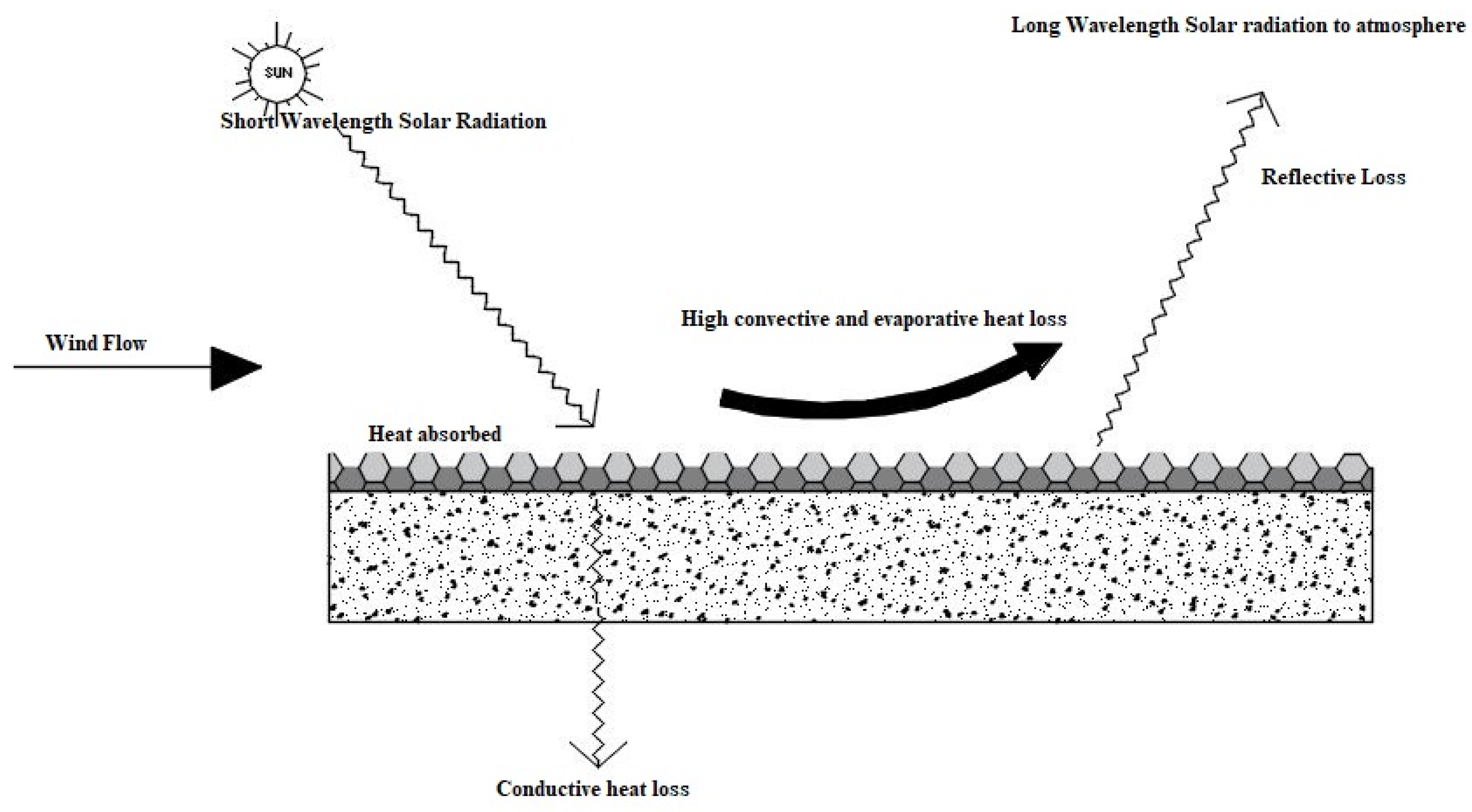
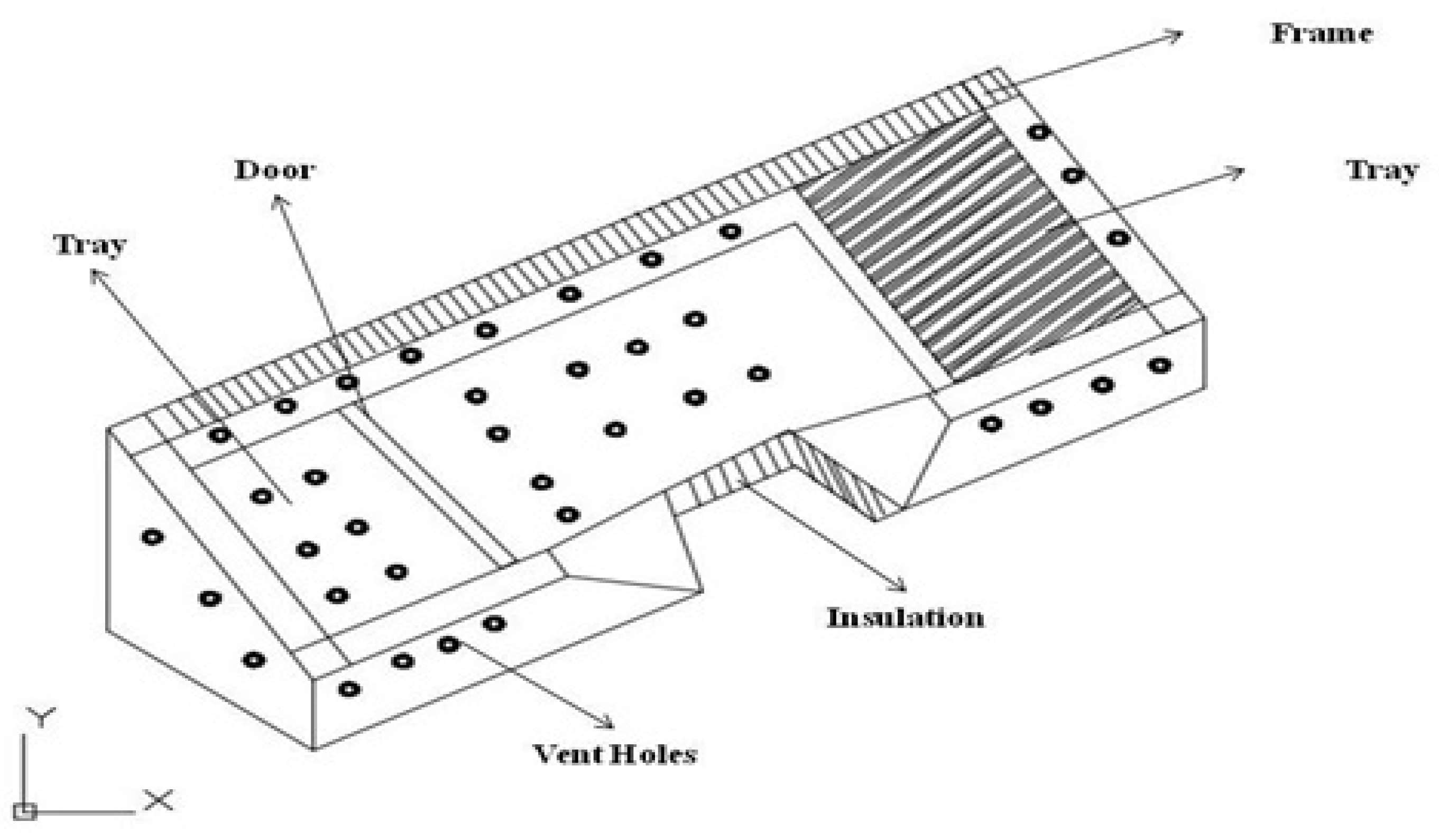
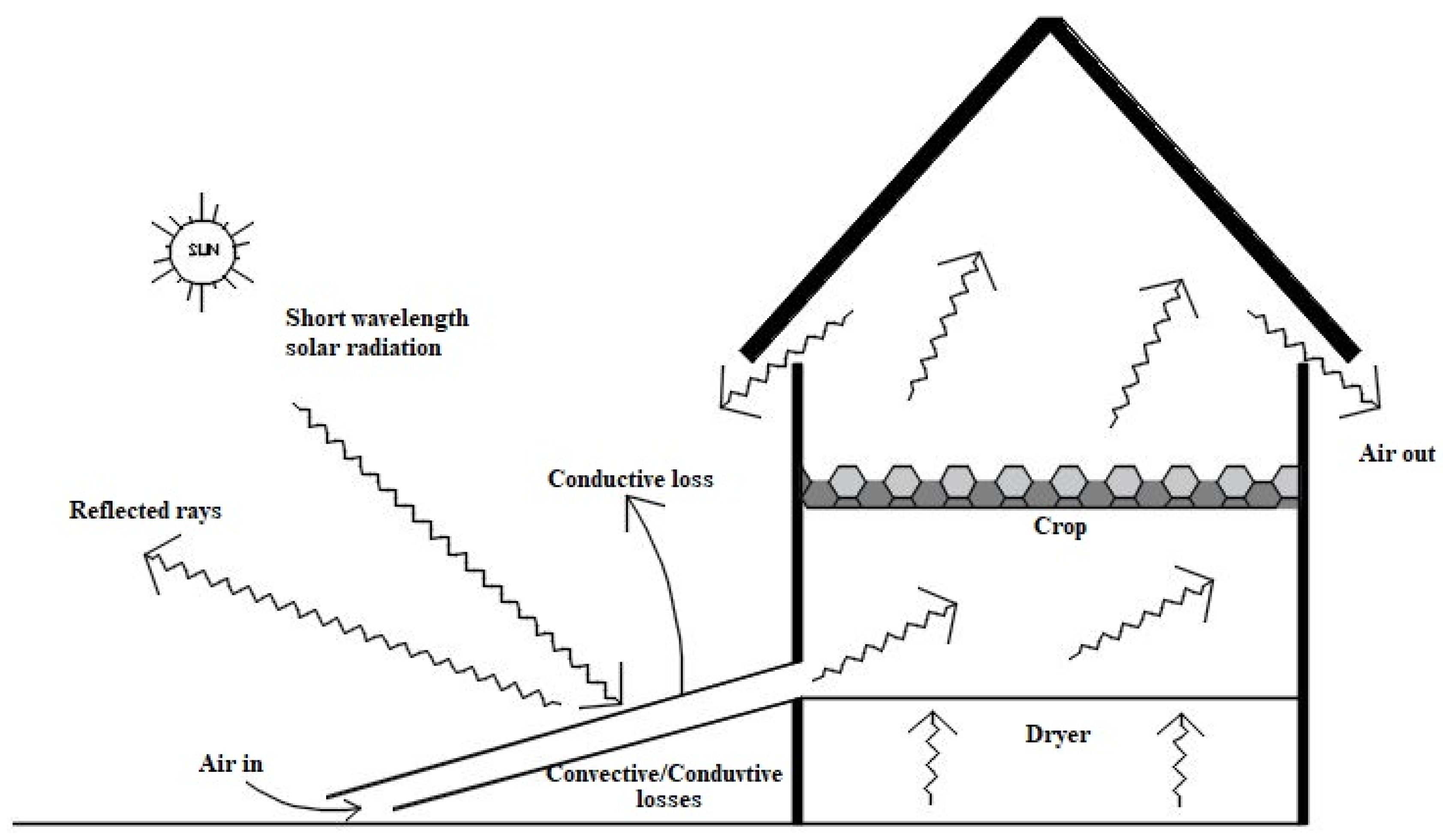
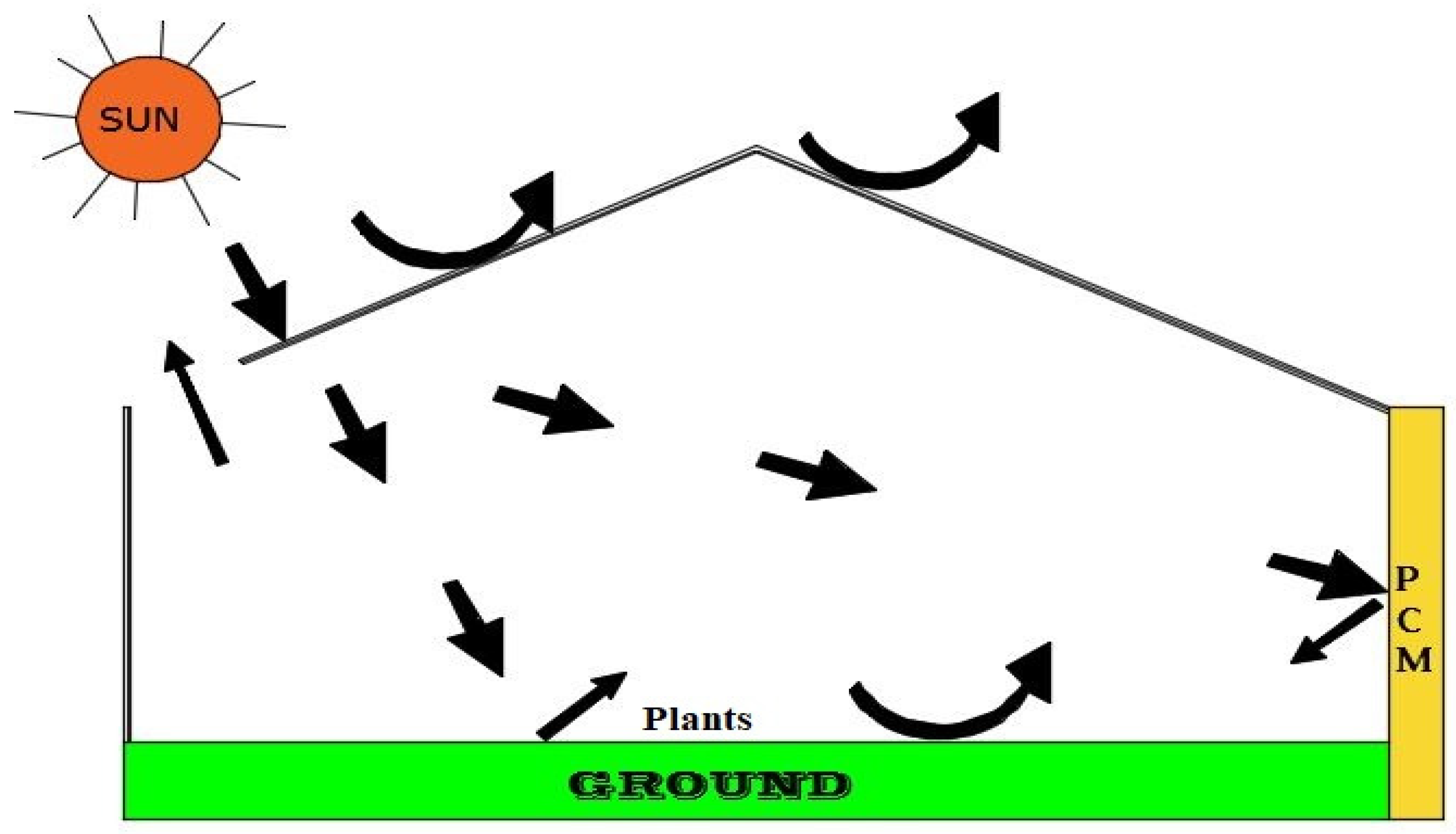
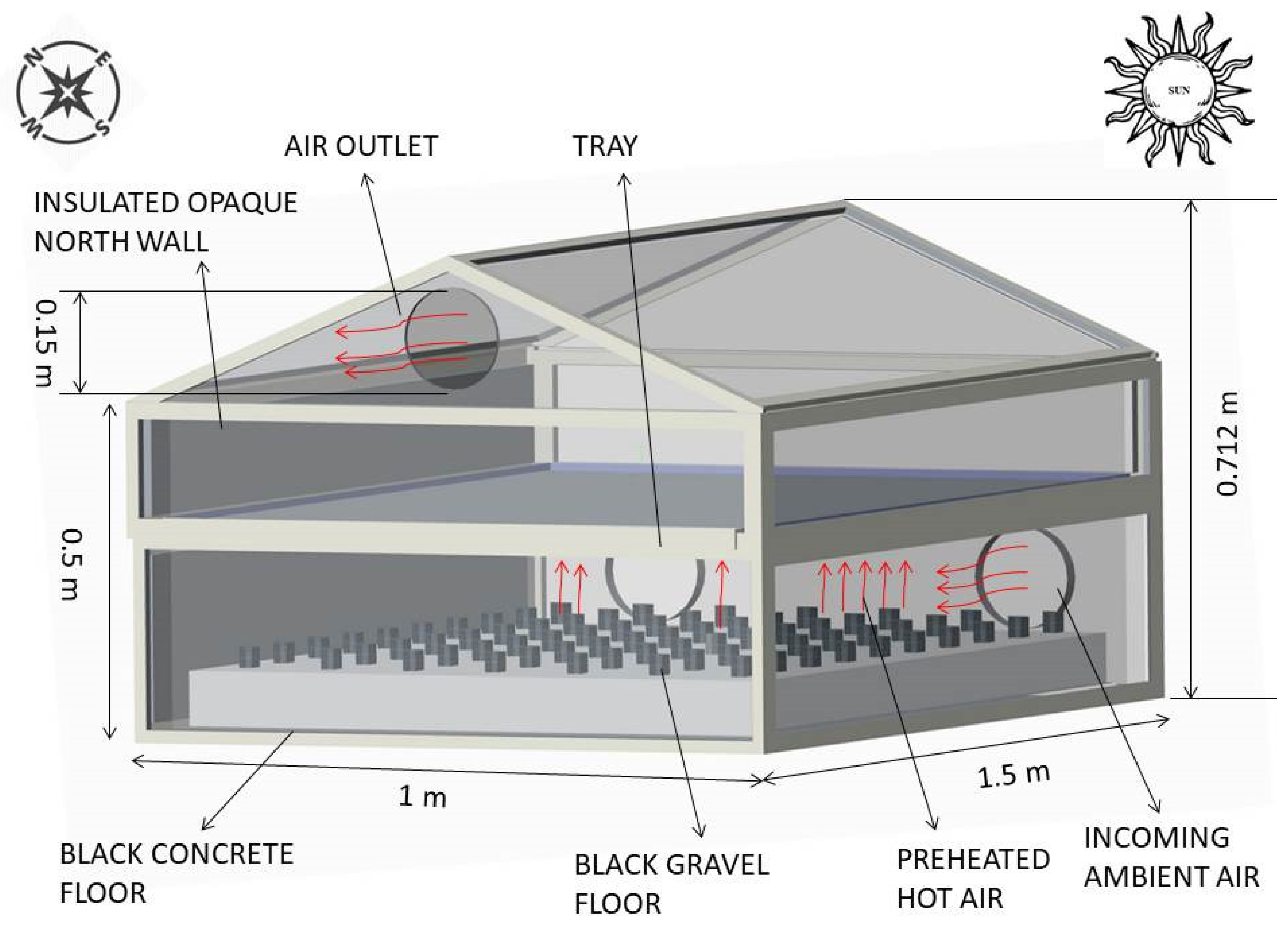
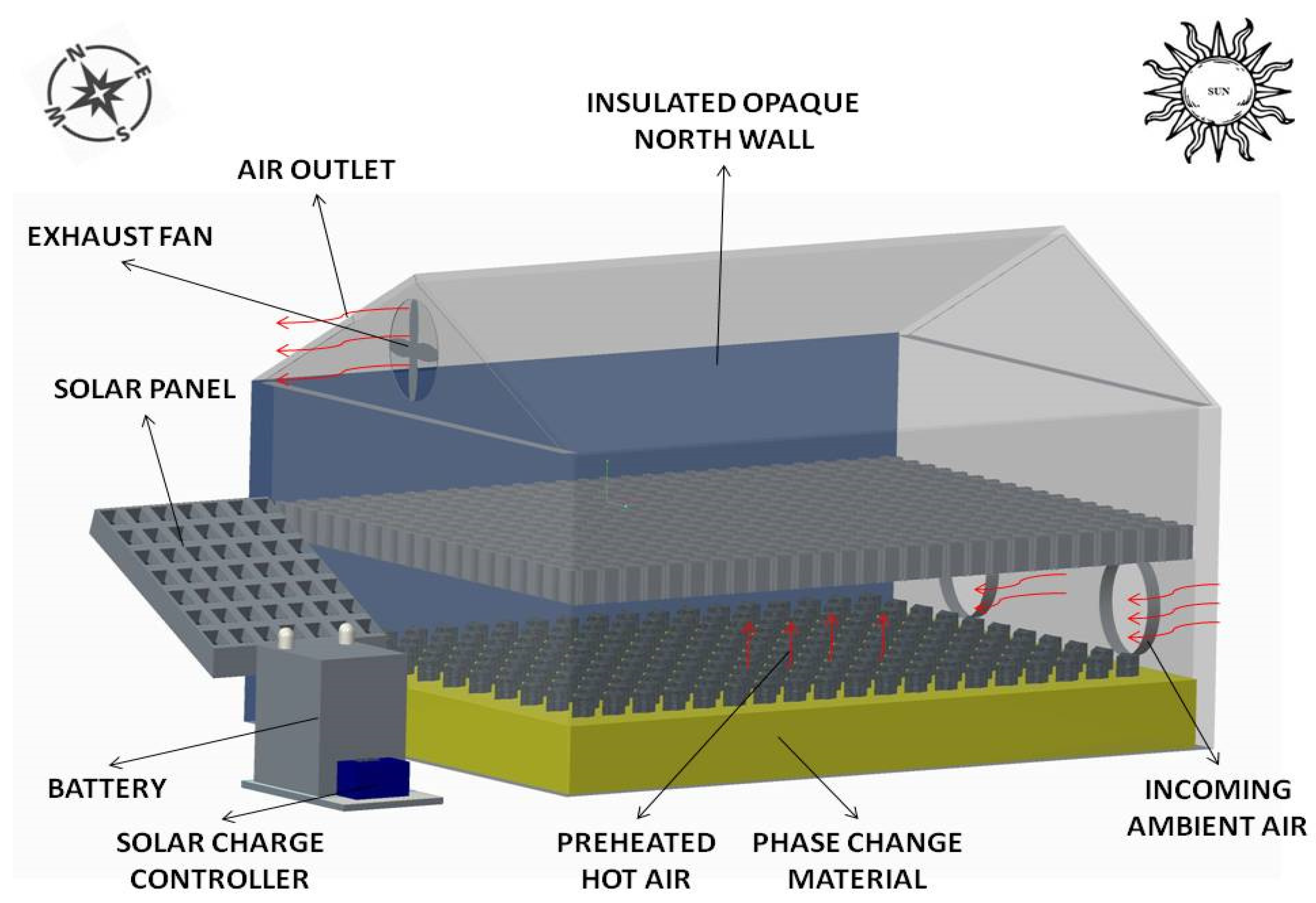
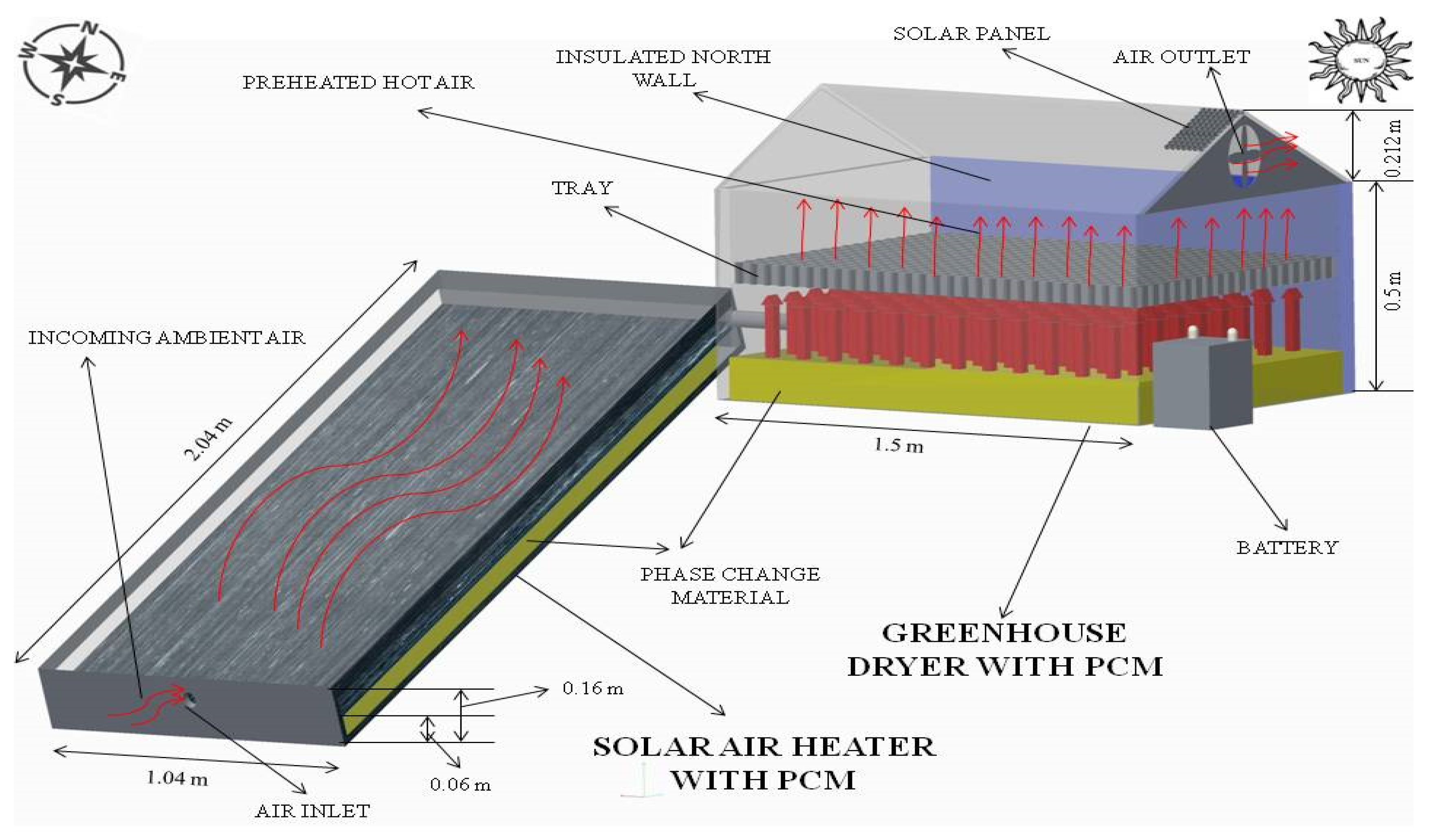
| Sl. No. | Thermal Models | Equations |
|---|---|---|
| 1 | Newton | |
| 2 | Henderson andPabis | |
| 3 | Wang andSingh | |
| 4 | Page | |
| 5 | Logarithmic | |
| 6 | Prakash andKumar | |
| 7 | Ahmad andPrakash |
| Authors (Year) [Ref.] | Year | Types of Solar Dryer | Results/Significant Findings |
|---|---|---|---|
| Barnwal and Tiwari [77] | 2008 | Hybrid Photovoltaic-Thermal (PV/T) Greenhouse Dryer | Numerous experimental data, taken each hour, including grape surface temperatures, moisture evaporated, ambient humidity and air temperature, greenhouse humidity, and air temperature, were logged in order to assess the heat and mass transfer for the suggested system. |
| Tiwari et al. [104] | 2016 | Photovoltaic–Thermal (PV/T) Mixed Mode Greenhouse Solar Dryer | Thermal modelling for the PVT greenhouse dryer was created by taking into account several parameters suchas crop, greenhouse, and solar cell temperatures, among others. Exergy and thermal energy have been determined. |
| Moreno et al. [105] | 2016 | Solar Greenhouse Dryer | Experimental drying of pinus pinaster wood chips occurred in a solar greenhouse dryer. The benefits of the solar greenhouse dryer, for both cases, included reaching 10% of relative humidity, and ferwerdays were requiredfor this; such benefits were shown in the findings through mathematical modelling. |
| Morad et al. [102] | 2017 | Solar Tunnel Greenhouse Dryer | Three similar solar tunnel greenhouse dryers underforced conditionsmode were erected to dry peppermint plants. In comparison withdrying full plants, the data showed that drying peppermint leaves shortens the drying process and yields the largest percentage of volatile oil. |
| Chauhan and Kumar [49] | 2016 | Passive Greenhouse Dryer | The convective heat transfer coefficient, diffusivity coefficient, heat utilization factor, heat loss factor, and performance coefficient were evaluated as performance indicators for a newly constructed system. |
| Tham et al. [106] | 2017 | Solar Greenhouse Dryer Integrated with Heat Pump | An even span solar greenhouse dryer was created and used to dry Java tea and Sabah snake grass. Solar greenhouse dryers perform satisfactorily in clear weather, but theydoo not work as well at night or on wet days because of product rehydration, which is greatly influenced by high relative humidity in the surrounding air. |
| Janjai et al. [107] | 2018 | Parabolic Greenhouse Dryer | The performance of the dryer for drying litchi flesh was modeled using an ANN technique. The back-propagation approach was used to train the ANN model using drying data. Three sets of data were utilized to evaluate the ANN model, andseven different sets of data were usedfor training. |
| Khanlari et al. [86] | 2019 | Greenhouse Dryer | The drying time was significantly shortened by merging a T-SAH with a greenhouse dryer (GD). Additionally, the T-average SAH efficiency was found to be between 45.6 and 56.8%. |
| Aymen et al. [83] | 2019 | Solar Greenhouse Dryer | The findings of the experiment demonstrate that the experimental drying curves for drying red pepper lack a consistent rate period. Only the falling rate period is seen in the experimental drying curves. As a result, drying took two days instead of three in the SGD, and instead of threedays in the open sun. |
| Huddar and Kamoji [108] | 2019 | Passive Solar Greenhouse Dryer | According to the trial findings, the drying chamber effectiveness was 51.7% and its typical drying speed was 0.158 kg/h. Moreover, 12.42 kWh/kg of a specific energy wasconsumed, and 1.27 kg (5.26%) of moisture content wasremoved. There was a 41.2% overall reduction in moisture content. |
| Authors [Ref.] | Year | Types of Hybrid Dryer | Results/Significant Findings |
|---|---|---|---|
| Bassey [119] | 1986 | Hybrid Sawdust–Solar Dryer | A “hole-through-sawdust” burner generates steam through the use of a heat exchanger and direct solar energy. According to test results utilizing okra underno-load conditions, adryer operating between 40–70 °C may dry items twice as quickly as the conventional approach. |
| Ferreiraa et al. [109] | 2007 | Hybrid Solar–Electrical Dryer | A hybrid solar-electrical dryer with two chambers—a solar chamber and a drying chamber with an air heater—was examined. The device’s airflow was evaluated experimentally, and the average values of the temperature and mass flow were reported as functions of the surrounding environment. |
| Nandwani [120] | 2007 | Hybrid Solar–Food Processor | A hybrid food processor that serves many functions was created, and its different technical and usable elements were researched. Cooking, pasteurizing water, distilling small amounts of water (to remove various minerals), and drying household goods (fruits, vegetables, condiments/herbs, etc.) were activities that were undertaken using this processor. |
| Boughali et al. [121] | 2009 | Hybrid Solar–Electrical Dryer | The study was conducted in anewly designed air drying passage at a mass flow rate that ranged between 0.04 and 0.08 kg/m2s, which is a relatively high range. Most researchers did not adequately study this spectrum. |
| Amer et al. [111] | 2010 | New Hybrid Solar Dryer with Heat Exchanger | A hybrid solar dryer was conceived and built using a heat exchanger and direct solar energy. The dryer was used as a solar dryer on typical sunny days and as a hybrid solar dryer on cloudy days. With the help of electric heaters placed inthe water tank, and the heat energy that was saved in the water during the day, drying was also able to occurat night. By reusing around 65% of the drying air within the solar dryer, and by expelling a little portion of it outdoors, the dryer’s efficiency was increased. |
| Hossain et al. [30] | 2010 | Hybrid Solar Dryer with FPC | A hybrid solar dryer prototype was created for tomato drying. It wasmade up of a drying unit, heat storage with an auxiliary heating unit, and a flat-plate concentrating collector. The dryer was tested in a variety of climatic and operational circumstances. |
| Reyes et al. [122] | 2013 | Hybrid Solar Electric Dryer | A hybrid solar dryer equipped with electric resistances and a 3 m2 solar panel was used for mushroom drying. SCD Model was used to estimate the effective diffusivity given that theR2 value was greater than 0.98, in accordancewith the literature. |
| Reyes et al. [114] | 2014 | HybridSolar Dryer with electric resistance and Paraffin wax | Three empirical models allowed for an adequate adjustment of drying kinetics. The Guggenheim–Anderson–de Boer and Peleg models provide reliable adjustments for the sorption isotherms. Energy was saved in the range of 6.6–12.5% as a result of the solar energy intake. |
| Okoroigwe et al. [113] | 2015 | Solar–Biomass Hybrid Dryer | The heat exchanger and back pass solar collector improved the tray temperature during no-load conditions. |
| Yassen and Al-Kayiem [123] | 2016 | Hybrid Solar/Thermal Dryer | Experimental research was conducted in orderto determine whether the hybrid solar-thermal drying system with arecovery dryer would perform better than the system without recovery. The investigations were carried out in two operational modes for drying red chili: thermal mode and hybrid mode. |
| Eltawil et al. [124] | 2018 | Hybrid Solar PV Tunnel Dryer With Solar Collector | Results showed that the designed dryer required 210 to 360 min to dry peppermint, but open-air sun drying required 270 to 420 min. |
| Amer et al. [125] | 2018 | Hybrid Solar Dryer Coupled With Electric Air Heater | For a better drying performance, the dryer was connected to an electric air heater with auto control and a blackened absorber surface. Ginger was dried using the natural convection mode. |
| Poonia et al. [126] | 2018 | PV/T Hybrid Solar Dryer | The root mean square error (RMSE), coefficient of determination (R2), and reduced chi-square (2) between the observed and estimated MR was used to compare the drying models’ performance. |
| Amjad et al. [91] | 2020 | Solar–Gas Hybrid Dryer | A thorough thermal analysis (based on energy and exergy) was carried out ona newly created inline airflow solar hybrid dryer (coupled with a gas burner and solar evacuated tube collector). Green chilies were used in the studies, and they were heated to 60 °C using three different heating sources: dual source (gasandsolar), gas, and solar. |
| Hao et al. [127] | 2020 | New Hybrid Solar Dryer coupled with FPSC and DF-FPSC | By using various operation strategies, the novel hybrid solar dryer application can regulate the air temperature in the drying chamber within a desirable range. By contrasting open sun drying with the hybrid solar drier, drying trials for lemon slices were carried out (OSD). |
Publisher’s Note: MDPI stays neutral with regard to jurisdictional claims in published maps and institutional affiliations. |
© 2022 by the authors. Licensee MDPI, Basel, Switzerland. This article is an open access article distributed under the terms and conditions of the Creative Commons Attribution (CC BY) license (https://creativecommons.org/licenses/by/4.0/).
Share and Cite
Ahmad, A.; Prakash, O.; Kumar, A.; Chatterjee, R.; Sharma, S.; Kumar, V.; Kulshreshtha, K.; Li, C.; Eldin, E.M.T. A Comprehensive State-of-the-Art Review on the Recent Developments in Greenhouse Drying. Energies 2022, 15, 9493. https://doi.org/10.3390/en15249493
Ahmad A, Prakash O, Kumar A, Chatterjee R, Sharma S, Kumar V, Kulshreshtha K, Li C, Eldin EMT. A Comprehensive State-of-the-Art Review on the Recent Developments in Greenhouse Drying. Energies. 2022; 15(24):9493. https://doi.org/10.3390/en15249493
Chicago/Turabian StyleAhmad, Asim, Om Prakash, Anil Kumar, Rajeshwari Chatterjee, Shubham Sharma, Vineet Kumar, Kushagra Kulshreshtha, Changhe Li, and Elsayed Mohamed Tag Eldin. 2022. "A Comprehensive State-of-the-Art Review on the Recent Developments in Greenhouse Drying" Energies 15, no. 24: 9493. https://doi.org/10.3390/en15249493
APA StyleAhmad, A., Prakash, O., Kumar, A., Chatterjee, R., Sharma, S., Kumar, V., Kulshreshtha, K., Li, C., & Eldin, E. M. T. (2022). A Comprehensive State-of-the-Art Review on the Recent Developments in Greenhouse Drying. Energies, 15(24), 9493. https://doi.org/10.3390/en15249493







